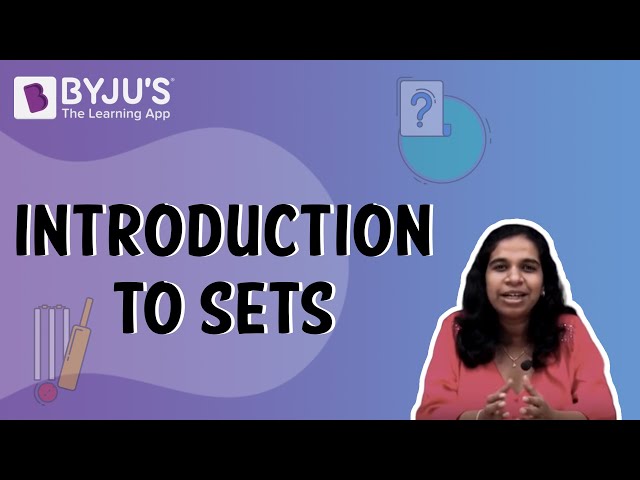Set theory symbols: In Maths, the Set theory is a mathematical theory, developed to explain collections of objects. Basically, the definition states that “it is a collection of elements”. These elements could be numbers, alphabets, variables, etc. The notation and symbols for sets are based on the operations performed on them, such as the intersection of sets, the union of sets, the difference of sets, etc.
Get more: Maths symbols
You must have also heard of subset and superset, which are the counterpart of each other. The different types of sets in Mathematics set theory are explained widely with the help of Venn diagrams. Sets have turned out to be an invaluable tool for defining some of the most complicated mathematical structures. They are mostly used to define many real-life applications. Apart from this, there are also many types of sets, such as empty sets, finite and infinite sets, etc.
| Table of Contents: |
What is Set Theory in Maths?
As we have already discussed, in mathematics set theory, a set is a collection of different types of objects, and collectively it is called an object. For example, numbers 8, 10, 15 and 24 are 4 distinct numbers, but when we put them together, they form a set of 4 elements, such that {8, 10, 15, 24}.
In the same way, sets are defined in Maths for a different pattern of numbers or elements. Such as, sets could be a collection of odd numbers, even numbers, natural numbers, whole numbers, real or complex numbers and all the set of numbers which lies on the number line.
Set Theory in Maths – Example
Set theory in Maths has numerous applications. Let’s imagine you’re in a class of 24 students (including you). You want to know the number of males and females in your class. So you begin counting: Males: 1, 2, 3,… 12; females: 1, 2, 3,… 12 . Set theory can now be used to demonstrate this more clearly.
A = {Rahul, Leena, Akshay, Preethi,…}
Here, the letter A represents your class.
A’s cardinality (the number of elements it contains) is 24.
I.e., |A|=24.
So there are 12 males and 12 females, right?
Let’s understand it by an example.
Now, F represents all females, while M represents all males.
F = {Leena, Preethi…}
|F|=12 (F’s cardinality is 12)
M={Rahul, Akshay,…}
|M|=12 (M’s cardinality is 12)
As a result, the sets are really useful for classifying things.
History
A famous mathematician, Georg Cantor, generated a theory of abstract sets of entities and formed it into a mathematical discipline between the years 1874 and 1897. This theory in maths is built out of his research of some definite problems about specific types of infinite sets of numbers which are real. According to Cantor, the set is a collection of definite, distinct objects or items of observation as a whole. These items are called elements or members of the set. However, he found it by a single paper based on the property of the combination of all real numbers (or real algebraic numbers).
Mathematics Set Theory Symbols
Let us see the different types of symbols used in Mathematics set theory with their meanings and examples. Consider a Universal set (U) = {1, 2, 7, 9, 13, 15, 21, 23, 28, 30}
Symbol |
Symbol Name |
Meaning |
Example |
| { } | set | a collection of elements | A = {1, 7, 9, 13, 15, 23},
B = {7, 13, 15, 21} |
| A ∪ B | union | Elements that belong to set A or set B | A ∪ B = {1, 7, 9, 13, 15, 21, 23} |
| A ∩ B | intersection | Elements that belong to both the sets, A and B | A ∩ B = {7, 13, 15 } |
| A ⊆ B | subset | subset has few or all elements equal to the set | {7, 15} ⊆ {7, 13, 15, 21} |
| A ⊄ B | not subset | left set is not a subset of right set | {1, 23} ⊄ B |
| A ⊂ B | proper subset / strict subset | subset has fewer elements than the set | {7, 13, 15} ⊂ {1, 7, 9, 13, 15, 23} |
| A ⊃ B | proper superset / strict superset | set A has more elements than set B | {1, 7, 9, 13, 15, 23} ⊃ {7, 13, 15, } |
| A ⊇ B | superset | set A has more elements or equal to the set B | {1, 7, 9, 13, 15, 23} ⊇ {7, 13, 15, 23} |
| Ø | empty set | Ø = { } | C = {Ø} |
| P (C) | power set | all subsets of C | C = {4,7},
P(C) = {{}, {4}, {7}, {4,7}} Given by 2s, s is number of elements in set C |
| A ⊅ B | not superset | set X is not a superset of set Y | {1, 2, 5} ⊅{1, 6} |
| A = B | equality | both sets have the same members | {7, 13,15} = {7, 13, 15} |
| A \ B or A-B | relative complement | objects that belong to A and not to B | {1, 9, 23} |
| Ac | complement | all the objects that do not belong to set A | We know, U = {1, 2, 7, 9, 13, 15, 21, 23, 28, 30}
Ac = {2, 21, 28, 30} |
| A ∆ B | symmetric difference | objects that belong to A or B but not to their intersection | A ∆ B = {1, 9, 21, 23} |
| a ∈ B | element of | set membership | B = {7, 13, 15, 21},
13 ∈ B |
| (a, b) | ordered pair | collection of 2 elements | (1, 2) |
| x ∉ A | not element of | no set membership | A = {1, 7, 8, 13, 15, 23}, 5 ∉ A |
| |B| | cardinality | the number of elements of set B | B = {7, 13, 15, 21}, |B|= 4 |
| A × B | cartesian product | set of all ordered pairs from A and B | {3,5} × {7,8} = {(3,7), (3,8), (5,7), (5, 8)} |
| N1 | natural numbers / whole numbers set (without zero) | N1 = {1, 2, 3, 4, 5,…} | 6 ∈ N1 |
| N0 | natural numbers / whole numbers set (with zero) | N0 = {0, 1, 2, 3, 4,…} | 0 ∈ N0 |
| Q | rational numbers set | Q= {x | x=a/b, a, b ∈ Z} | 2/6 ∈ Q |
| Z | integer numbers set | Z= {…-3, -2, -1, 0, 1, 2, 3,…} | -6 ∈ Z |
| C | complex numbers set | C= {z | z = a + bi, -∞<a<∞, -∞<b<∞} | 6 + 2i ∈ C |
| R | real numbers set | R= {x | -∞ < x <∞} | 6.343434 ∈ R |
Basic Concepts of Set Theory
In set theory, various concepts are discussed at various levels of education. The basic concepts include representation of a set, types of sets, operations on sets (such as union, intersection), the cardinality of a set and relations, etc. Some of the basic concepts involved in set theory are as follows:
Universal Set
A universal set is usually denoted by the capital letter ‘U’. Also, sometimes it is denoted by ε(epsilon). It is a set that contains all the elements of other sets including its own elements.
U = {counting numbers}
Complement of Set
If A is a set, then the complement of set A will contain all the elements in the given universal set (U), that are not in set A. It is usually denoted by A’ or Ac.
Set Builder Notation
The examples of notation of set in a set builder form are:
- If A is the set of real numbers.
A = {x: x∈R} [x belongs to all real numbers]
- If A is a set of natural numbers
A = {x: x>0]
Applications
Set theory has many applications in mathematics and other fields. They are used in graphs, vector spaces, ring theory, and so on. All these concepts can be defined as sets satisfying specific properties (or axioms) of sets. Also, the set theory is considered as the foundation for many topics such as topology, mathematical analysis, discrete mathematics, abstract algebra, etc.
Video Lesson on What are Sets

Solved Examples
1. Let A and B be two finite sets such that n(A) = 20, n(B) = 28 and n(A ∪ B) = 36, find n(A ∩ B).
Solution: Since, n(A ∪ B) = n(A) + n(B) – n(A ∩ B).
So, n(A ∩ B) = n(A) + n(B) – n(A ∪ B)
= 20 + 28 – 36
= 48 – 36
= 12
2. Let A = {x : x is a natural number and a factor of 18} and B = {x : x is a natural number and less than 6}. Find A ∪ B.
Solution: Given,
A = {1, 2, 3, 6, 9, 18}
B = {1, 2, 3, 4, 5}
Therefore, A ∪ B = {1, 2, 3, 4, 5, 6, 9, 18}
3. Let A = {3, 5, 7}, B = {2, 3, 4, 6}. Find (A ∩ B)’.
Solution: Given, A = {3, 5, 7}, B = {2, 3, 4, 6}
A ∩ B = {3}
Therefore,
(A ∩ B)’ = {2, 4, 5, 6, 7}
4. If A = {2, 3, 4, 5, 6, 7} and B = {3, 5, 7, 9, 11, 13}, then find (i) A – B and (ii) B – A.
Solution: Given,
A = {2, 3, 4, 5, 6, 7} and B = {3, 5, 7, 9, 11, 13}
(i) A – B = {2, 4, 6}
Practice Questions on Set Theory Symbols
- If A = {1, 3, 5, 7} and B = {2, 3, 4, 5}, then find AUB.
- Let P = {a, e, i, o, u} and Q = {a, b, c, d, e}. Find P∩Q.
- If A = {1, 2, 3, 4, 5} and B = {2, 5, 7, 9, 11}, then find A – B.
Download BYJU’S-The Learning App and learn many mathematical concepts with the help of personalised videos.
Frequently Asked Questions Set Theory Symbols
What does ∈ mean?
What does ∩ mean in math?
What does ⊆ mean in math?
What is the symbol for union of sets?
If A = B, then what does it represent?
A = {1,2,3} and B = {3,2,1}
Hence, A = B



Symbol used in sets class 7
This app is really helpful for me
^ used for power .
example: – 2^2=4
therefor, it means that 2 power 2 is 4
This app is very helpful 😊